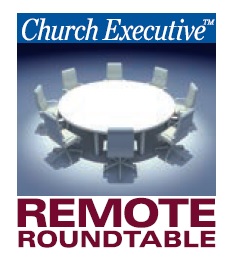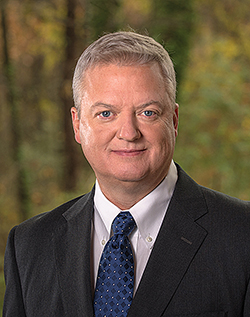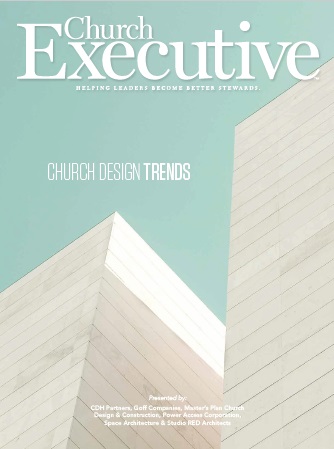Emerging trends, outdated ones, and ministry-specific design movements

Partner
Studio RED Architects
 What’s especially appealing about working with churches?
What’s especially appealing about working with churches?
Trung Doan: Churches are the hands and feet of faith, and we consider it a privilege to equip churches to continue making a difference.
Rodney C. James: Mentoring, leading and helping pastors. Most didn’t get a class in church design, construction or remodeling.
Kerry Jones: Pastors are visionaries with a passion to touch people and build God’s kingdom. Churches are experts in building people, but often not at building facilities. It’s our ministry calling to partner with pastors and church leaders to provide expertise in facility expansion / renovation in a way that keeps the church financially healthy and provides a means to further advance both the Church’s mission and God’s kingdom.

President
Master’s Plan Church Design & Construction
Dan J. McCormack: Power Access Corporation was founded in 1972 — 18 years prior to passage of the Americans with Disabilities Act in 1990. We were among the first manufacturers of automatic door openers and one of the few resources available to churches concerned for their special needs members and visitors. We are grateful for the opportunity to partner with thousands of faith-based communities. We understand church budgets are stretched and recognize the greatest value for church resources is gained through mission and ministry. We provide a special church discount to make accessibility more cost-efficient. Facility committees use member-volunteers to perform installation of our door openers, supported by a 24/7 technical assistance resource. This further facilitates the use of funds for each church’s mission.

Director, Client Relations
Goff Companies
David Strickland: Each faith-based facility is unique, which presents exciting new challenges. But mostly, it’s the people. Church projects are often led by volunteers investing their time, talents and earthly riches. It’s inspiring to see and rewarding to be able to help them in the process.
Mark Allen: We feel that the Body of Christ provides the most important service on Earth — helping people find and follow Jesus! We’re honored that churches across the country have entrusted us to be a part of their team. We’re passionate about the Church, and the opportunity to express the creative gifts placed within us by God is not only a thrill but also an opportunity to create environments that honor God and inspire people!
As you look forward to 2020 and beyond, what design trends are you expecting to ‘pick up steam’ in the house-of-worship market, and why?
Jones: For some time, new church designs have included a large Commons area — typically around the size of the worship room seating area. This multifunction space is used for people connection, small groups and fellowship. We see this trend gaining momentum with AVL and other ministry components to accommodate special services, such as baptism and weddings.

Owner, CEO and President
Power Access Corporation
Security is another area to which churches are devoting significant resources. Secure children’s ministry areas have long been a high priority, and that continues. We’re also seeing a trend to enhance building security with the ability to quickly shut down areas of the building in the event of a shooter or other emergency.
The lowering cost of LED video components is making them very popular. So, they’re included in most new construction and renovations.
McCormack: Churches are increasingly incorporating accessibility on their campuses — and keeping members, and even their local communities, engaged in the process. It’s common practice among our church partners to use charitable contributions specifically for accessibility projects, including the installation of automatic door openers.

Principal
CDH Partners
Strickland: Adaptive reuse — many churches are repurposing their old buildings and finding old shopping centers or office buildings to convert into places of worship. This is an economical approach since the building envelope is generally the most costly part of a facility.
Technology is another trend we don’t expect to slow down. Churches are postponing additions of large worship centers and instead simulcasting services across their campus or to satellites. These are smart trends that allow churches to serve more members in ways that weren’t possible before, while simultaneously saving on costs.
Allen: Church design is as diverse as your home is from mine. We never think in terms of “design trends,” as they have an expiration date. Instead, through a detailed programming session and ongoing communication, we determine “what church type” we’re designing for and “what specifically” their ministry goals are. In great church design, the design team should often challenge previous notions of building design for more satisfying and effective ministry spaces.

Partner
SPACE Architecture
Doan: Community trendsetting is the process of leveraging a church facility to serve as an attractive community gathering area.
Walking into a church on Sunday morning might feel intimidating, but stopping by a community center on a Friday afternoon for a cup of coffee has a much lower barrier to entry.
These facilities can also serve as places for support groups to meet, students to study, and families to unwind and reconnect. Effective facilities can foster engagement and attendance growth, and provide a revenue source. Engaging outdoor areas and multipurpose spaces can fill the community center void, offering something for everyone, and prioritizing hospitality can help foster modern community.
James: Space that ministers to families with special needs children — safe, controlled, comfortable environments for their care and safety — are on the rise.
Design beyond Sunday is another momentous change, and I’m a huge proponent. Church is more than a weekend experience; it’s a Monday-through-Saturday lifestyle of meeting needs, ministering to others, and connecting with one another and the community.
Finally, design for connection. The current generation loves to download a message or learn on their commute, but they also need to connect with others. We must offer spaces for that, all week — and for young people, well into the night hours.
Likewise, are there design trends that are likely to fall off, popularity-wise? Why?

Strickland: Large reception desks. Instead of a greeter standing behind a kiosk, he or she can be more proactive in meeting guests in a space designed for seating and gathering. This makes the entrance feel less transactional, and guests can feel like part of the group right away.
Allen: Since I need to say something about “design trends,” we’ve seen the church café design trend being eliminated by churches for a variety of reasons. The two primary ones are time (specialty brew addicts might miss the worship) and money (more ministry, less comfort).
Other trends that we think might change include sanctuary stadium seating (the negative can be that it gives people a place to escape from the community) and the elimination of sports fields and other site amenities (communities already provide them, and eliminating them frees up additional funding for ministry and promotes more community interaction/participation outside the church’s walls.
I will mention here that we don’t consider haze-and-light shows “design trends.” Rather, we consider them to be vital elements in certain types of churches for which the mission is to be seeker-intense.
Doan: Single-focus spaces, to serve only congregants, will continue to decline in popularity. We’re now seeing worship spaces double as concert venues and Sunday school classrooms being used by community organizations all week.
James: Large, multi-venue campuses are being replaced with multiple single-building locations that reach and connect with people in geographically centered locations.
Jones: A few years ago, it was common to see 3-D images with cars, rollercoasters and other objects coming through walls. While theming is still very popular, the types of theming seem to be more subtle, using architectural components, shapes, colors and video.
Also, worship room seating sizes are getting smaller. While some are still being built, we’re seeing fewer rooms in the 3,000-plus-seats range. Churches are opting for smaller spaces (around 1,500 seats) and then going multi-campus to accommodate growth.
Let’s talk about church design trends you see on the horizon related to specific, critical ministry groups:
Children
Strickland: While our shared goal is always to provide secure environments children are excited about, the trend is to make these spaces more customized and larger-than-life. Children thrive in special places they intrinsically know are just for them. Plus, it’s easier on parents if their kids have a place they look forward to going.
Allen: More security — every church is unique in how it handles security; the solutions vary from total lockdown to complete freedom of access to all. We believe (like most everyone) that the safety of children is job No. 1 and that each church, with our help, defines its solution. Due to the direction our culture is going, we expect security will increase over the next few years at all churches.
Less theming — I’m not attempting to discourage wonderfully themed children’s areas; however, I believe what the children hear and feel in their hearts is far more important than what they see with their eyes. I believe we’re sometimes creating incredibly themed children’s spaces for the adults, not the children. Have you noticed that a child will often play more with the box the gift came in than the gift?
Doan: Consider a nursery that can be used throughout the week, an outdoor playground and lawn, and technology-enabled classrooms for various age groups. Beyond traditional uses, these can be enjoyed by a variety of community groups, including Girl Scouts, Boy Scouts, school clubs, and sports teams.
James: Creating space for ministry, not just childcare, is critical — for worship, play, teaching and fun. Moms love available children’s space during the week, and it provides connection with other mothers.
And of course, safety and security are always priorities.
Jones: Reaching young families with school-aged children living at home is a priority, and it requires a secure, dynamic children’s ministry area and program.
In our culture, it’s important to understand that children take their parents to church. They’re attracted to facilities that don’t look like their school buildings. So, areas with modern theming and video components are very common.
Additionally, parents must feel like their children are in a secure environment.
McCormack: Children love to explore and tinker. And it’s the little things in life that bring the greatest joy. Imagine arriving the first time to see a “magic” button that allows Grandma and Grampa, or other family members, to walk through a door that opens by itself. The next week, brothers and sisters are running to be first at the button!
Youth
Doan: Youth want independence. Provide them with an exclusive space, away from their parents and separate from a dedicated children’s space.
Incorporate areas with large-screen televisions for youth to play games, on a variety of systems.
Also, integrate unique presentation tools that allow anyone attending church events to follow along and interact with by using their electronic devices.
James: The right youth space feels like “their own church.” It’s a place to hang out, connect, go all week, worship and learn. Creating a vibe that students feel “fits” makes them want to bring others along.
For senior high students, separation from the main crowd is important.
McCormack: Many churches sponsor youth organizations that engage their members in the process of volunteer fundraising for accessibility projects. The Scouts BSA, Girl Scouts and many other volunteer groups are regularly involved in this process. Raising funds is accomplished by the coordinated efforts of church leaders, parents and youth — a perfect opportunity to share and grow faith among our young communities.
Strickland: Increasingly, churches are calling upon us to reimagine their youth ministry. It’s all about sparking engagement — flexible spaces that provide youth with opportunities to worship, study or socialize in their own way. Designs often include digital technology, full-service cafés, movie rooms, game rooms, a variety of seating styles, and assembly space. The environment should be energetic and unique.
Millennials
Doan: Millennial church attendance is declining at an alarming rate. One reason is that Millennials want to feel like they’re experiencing a genuine environment, without consumerism involved. So, creating simple, engaging spaces is essential — coffee shops, greenspaces and flexible meeting areas for organic fellowship.
James: Millennials and Generation Zers are hypersensitive to good use of space; it must have a purpose beyond a meeting room. So, multipurpose space is a good investment.
Also, they care more about how a space feels and functions than its architecture. They use words like “warm,” “inviting” and “open,” not “beautiful,” “ornate” or “liturgical.”
Jones: We’re seeing an effort to target Millennials with co-working spaces and extended-hour coffee venues. Often, these are located in the Commons area.
Strickland: Lately, churches are looking for a central fellowship hub — especially Millennials and young adults. These spaces have a streamlined look that invites active, dynamic experiences.
We make sure the interior design is contemporary and vibrant, with updated finishes and new audio/visual technology that are appealing and comfortable for all groups.
Young families
James: A safe, secure, well-marked church campus is key.
The first impression should convey there’s a ministry for the entire family. Young families want to know: What needs is my church meeting? Are my children well cared for and taught the Word? Are my marriage and finances ministered to? Is there an opportunity to use my gifts? Does church connect us with others doing life like us?
Young families are uncomfortable leaving their kids at a distance, so your children’s space shouldn’t be a building away from the entry or main worship area.
Inviting, clean and life-giving space communicates that a church values children.
McCormack: The challenge is to pass faith along to our children. The good news is that the largest attending population is in the 30– to 49-year-old range. They’re raising families, and many begin to attend church with aging parents.
As accessibility issues arise among older individuals, church entrances and restroom doors must present a pathway rather than a hindrance. This is critical to sustain family involvement, especially in the face of declining church attendance.
Doan: We’re seeing an increased emphasis on inviting, safe children’s spaces, and areas dedicated to fostering community among parents. Community-focused, family events are occurring more often on church campuses, including back-to-school rallies, fall festivals and outdoor movie nights, driving the need for family-focused indoor and outdoor church spaces.
As churches expand their campuses to attract and accommodate new members, they also want to ensure longstanding members (some, no doubt, resistant to change) are engaged in the process. How can church leaders walk this fine line?
Strickland: When we approach a project, we start with the church’s mission. The mission defines the church’s ministries, and their ministries define the development of their facilities. This also ensures everyone starts on the same page.
As architects, it’s our responsibility to keep stakeholders — including longstanding members — engaged in and comfortable with the process. Doing so makes people more open to change.
Once the project generates momentum, there are great opportunities to create a vision that everyone understands. This provides the best results for a phased development plan to meet the facility needs at each step of the church’s journey. In the end, it ensures the facilities align with the mission and ministries.
McCormack: The second largest attending population in churches is between 50 and 64, followed by the 65+ age group. The active engagement of church leaders, elderly members, parents and youth in accessibility projects presents the unique opportunity to bridge the faith gap between generations, and encourage the most efficacious human endeavor — face-to-face communication and accomplishment.
Allen: We believe that the intense programming process in which we engage with the church clarifies the church type, and the church type clarifies how and why we should design for both newcomers and long-standing members.
Some churches are far more concerned with maintaining membership; others are completely dedicated to new converts. Both are concerned with the needs of the other group, but their dominant type directs their mission, and their mission directs their building design.
Doan: Collaboration is the key to creating a space that attracts new members and ensures long-standing members are happy.
To better understand the programmatic needs of a church, our team discusses goals with staff members and other stakeholders and surveys the congregation. The information gathered is then used to define spaces, adjacencies and priorities, effectively molding the design of new facilities. We then determine the right areas for growth, adjacencies that align with internal processes, how to maximize the use of resources, and how existing facilities can be modernized to best meet current and future needs.
James: Using technology is one of the best ways to create space for multigenerational congregations. Even amid long-standing architectural elements, new video and lighting creates a completely different feel.
A team that has designed for ministry from the last decade to present day can encourage and coach pastors. Our job is to lead, help, and provide them with tools to communicate the “why” of changing design trends.
Jones: This is a very important issue. Churches can’t simply turn their backs on the legacy group when reaching for future growth. It’s disrespectful of those who brought the church to where it is today, and it has the potential to alienate a group of people who can help to fund and staff new ventures.
Creating spaces specifically for the legacy group to accommodate fellowship, or a venue that allows for a traditional style of worship, can show honor and gain buy-in.



Great article